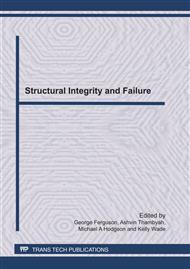p.3
p.7
p.11
p.15
p.19
p.23
p.27
p.31
Effects of Crack Size and Crack Face Interference on Shear Fatigue Crack Growth in a Bearing Steel
Abstract:
The near-threshold fatigue behavior of small, semi-elliptical surface cracks in a bearing steel was investigated under cyclic shear-mode loading in ambient air. Fully-reversed cyclic torsion was combined with a static axial compressive stress to obtain a stable shear-mode crack growth in the longitudinal direction of cylindrical specimens. Shear stress amplitude was gradually decreased with an increase in crack length and the crack finally became non-propagating. Abrasive wear on the crack faces was inferred by debris and also by changes in microstructure in the wake of crack tip. Further, it was found that these effects resulted in a significant decrease in the crack growth rate. In this study, we shed light on the important role of the crack size and crack face interference on the crack growth behavior.
Info:
Periodical:
Pages:
15-18
Citation:
Online since:
July 2011
Authors:
Keywords:
Price:
Сopyright:
© 2011 Trans Tech Publications Ltd. All Rights Reserved
Share:
Citation:


